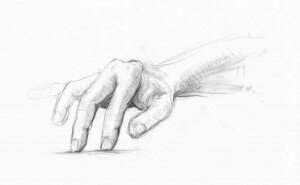
Drawing of pianist’s hand by Sonya Ardan from ‘The Craft of Piano Playing’ by Alan Fraser
C. P. E. Bach.
From our earliest time at the piano, we are taught a “5-finger position”, which follows the natural shape and arc of the hand, and learn that consistent and carefully planned fingering schemes help us get around the music comfortably and economically. It enables us to play legato, or vivace – and everything in between. Fingering schemes are not set in stone, but once learnt, a scheme tends to stay in the fingers forever – return to a piece which you learnt, say, 10 years ago and you may be surprised at how much of the fingering is retained. A good fingering scheme informs the pianist’s memory, ensuring accuracy and fluency of playing, and should be both musical and natural.
Working out our own fingering enables us, as pianists, to find a scheme which suits our own hands, for each hand is unique and there is no such thing as a “one size fits all” fingering scheme (though many students and even some teachers adhere to this approach). Many editions of piano music, especially study books and exam editions, come with quite involved, suggested fingering – but it should be remembered that these schemes are just that: suggestions, and if a scheme does not work for a particular pianist, it can and should be changed.

© Bryan Reinhart
Chopin: Ballade No 1 in G minor (Evgeny Kissin)
Fingers, combined with an active, mobile wrist and arm, allow us to spring from note to note (as in staccato passages) or achieve jumps around the keyboard. A lift and a drop creates definition and articulation of phrases, while the thumb (treated as a “finger” for the purposes of piano playing) acts like a rhythmic divider; for example, to define the opening of a group of notes, much as a string player would bow them.
Ultimately, the goal of fingering is to serve expression and to achieve the most beautiful and effective sound possible.
“To produce the best effect, by the easiest means, is the great basis of the art of fingering,”
Muzio Clementi
Prokofiev: Toccata (Haochen Zhang)




